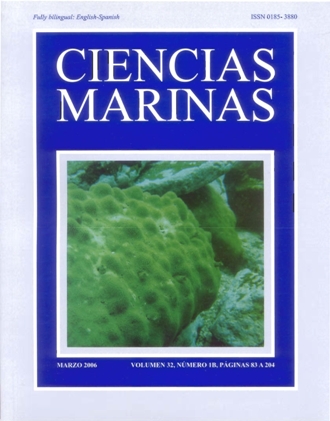Temporal variation in the regeneration rate of artificial lesions in two morphotypes of Porites panamensis
Main Article Content
Abstract
The regeneration of artificial lesions in the columnar and massive forms of the nominal taxon Porites panamensis was compared, in order to contribute to the knowledge of the physiology of the species complex and to help clarify the taxonomic situation of the phenoms. The study was carried out at Punta Gaviotas (24º17.134′N, 110º19.870′W) and Punta Galeras (24º21.236′N, 110º17.028′W), in La Paz Bay, Mexico. One circular lesion per colony (0.70 ± 0.09 cm diameter and 0.5 cm deep) was inflicted on 26 to 30 colonies at each site and the regeneration rate was compared during the cold season (19–22ºC, March–April 2004) and the warm season (28–30ºC, September–October 2004). The regeneration rate followed a negative exponential model for both forms of P. panamensis in both seasons, but the process was faster in the warm season than in the cold season, probably due to increased light availability for zooxanthellae at that time of year. We observed differences in the percentage of full regeneration between forms during the warm season and in the proportion of colonies invaded by algae in the lesion area, the massive form showing three times more damage than the columnar in both seasons. As the morphotypes of P. panamensis showed the same regeneration rate, it is suggested that they might represent the same species; however, the differences in susceptibility to algal colonization and in the percentage of complete recovery of the colonies might indicate a selective advantage of the columnar form over the massive one.
Downloads
Article Details
This is an open access article distributed under a Creative Commons Attribution 4.0 License, which allows you to share and adapt the work, as long as you give appropriate credit to the original author(s) and the source, provide a link to the Creative Commons license, and indicate if changes were made. Figures, tables and other elements in the article are included in the article’s CC BY 4.0 license, unless otherwise indicated. The journal title is protected by copyrights and not subject to this license. Full license deed can be viewed here.

